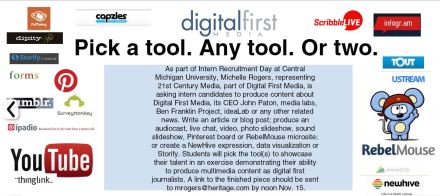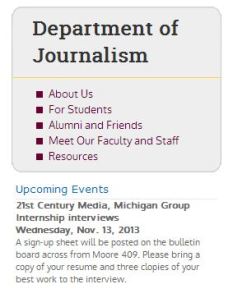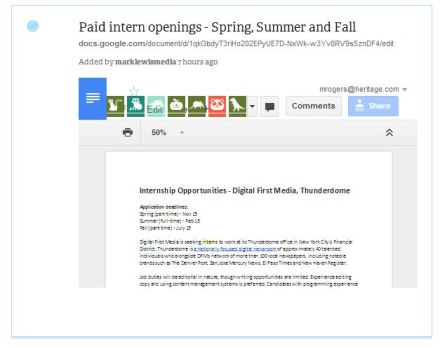For the first time, in my role as director of the Southeast Michigan Media Lab and as director of community engagement and editorial training for 21st Century Media’s Michigan Group, I’ll be recruiting interns from Central Michigan University. I initiated contact with CMU after seeing a post on Facebook that MLive would be there recruiting interns, and thought 21st Century Media should be doing the same.
What I hope will make the experience different for students with our media group is that I will ask candidates to demonstrate their digital storytelling skills. I will still ask them the standard questions about their backgrounds, passion for journalism and career goals, but I’ll also ask them to produce content about Digital First Media, its CEO, media labs or other related news using digital storytelling tools. What I am interested in seeing is their choice of tools, whether they choose to write a blog post; use Storify or RebelMouse; create a video, audiocast or photo slideshow; or maybe make a timeline or NewHive expression.
I created a NewHive expression to share the challenge with the students. I also will come armed with copies of Digital First Media’s recruitment brochure, list of editor contacts at our publications across Michigan, and internship opportunities at Digital First Media’s Thunderdome office in New York City’s Financial District.
Thunderdome is a nationally focused digital newsroom that works with more than 100 local newspapers, including The Denver Post, San Jose Mercury News, El Paso Times, New Haven Register and The Oakland Press.I’ll be meeting Jim Wojcik, the internship coordinator at CMU’s Department of Journalism. He has lined up a few students interested in interviewing with 21st Century Media. They’ve been asked to send a link to their resume and clips using Pressfolios. I’ll give the students a short deadline for turning around their digital-first assignment, and then make recommendations to our editors based on the candidates’ skills and location preferences, and editors’ needs.




